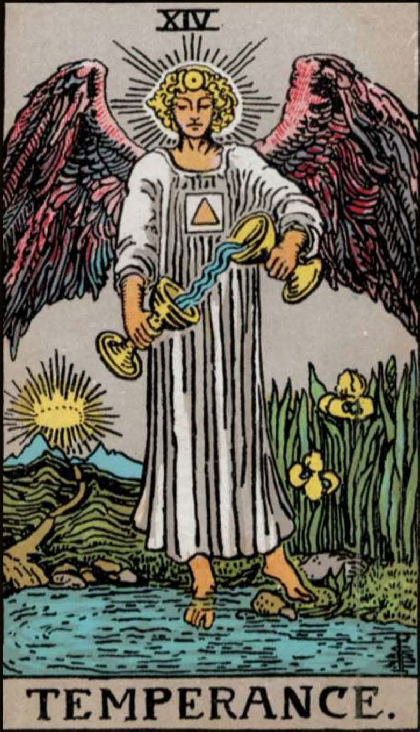The Temperance Tarot Card: Symbolism, History, and Meaning
The Temperance tarot card is a calming and balancing force in the tarot deck. Symbolizing balance, harmony, patience, and moderation, Temperance embodies the spirit of tranquility and healing. In this comprehensive guide, we'll delve into the historical origins, symbolism, and meanings of this peaceful card, offering insightful perspectives into its role in your tarot readings.
The Historical Origins of The Temperance Tarot Card
Temperance, the fourteenth card in the Major Arcana, has been part of tarot decks since their early days. Originally depicted as a person pouring liquid from one receptacle into another, the card has maintained its core symbolism of balance and moderation over time.
As tarot evolved towards divination, Temperance's interpretation expanded to include the harmonizing of opposites and the patient balancing of different aspects of life.
A Detailed Description of The Temperance Tarot Card
The Temperance card typically shows a winged angel. The angel is androgynous, symbolizing a balance between the genders. The angel has one foot on dry land, representative of the material world, and one foot in the water, representative of the subconscious. This is symbolic of the necessity to 'test the waters' before jumping headfirst into unknown circumstances, as well as a balance between the spiritual and material worlds.
The angel is shown mixing water between two cups, a symbol of the flowing and dynamic exchange of ideas and tempering of emotions, suggesting the need for balance and moderation. This also signifies alchemy and the blending of opposites to create something new.
The angel's robe is white, symbolizing purity, on top of which is a triangular emblem showing an enlightened soul. Above the angel's forehead, there's a circle representing wholeness and self-realization.
In the background, there is a narrow winding path that goes up to a golden crown radiant with light, symbolizing the path to enlightenment. There are irises, which are symbolic of hope and messages from angels, along the path. The mountains in the distance represent the loftiness of spiritual goals and ideals.
The Tranquil Symbolism of The Temperance Tarot Card
The Temperance tarot card is full of peaceful symbolism, each element contributing to its profound meaning:
The angel: Represents guidance, protection, and a higher consciousness that can harmonize different aspects of our lives.
The two cups: Symbolize the subconscious and conscious minds. The flow of water between them indicates the integration and balance of these two states of consciousness.
The land and water: Symbolize the material world and the realm of emotions and intuition, respectively. The figure's stance in both reflects the need to balance our practical needs with our emotional and spiritual ones.
The path and crown of light: Represent the journey and the ultimate goal of spiritual enlightenment and self-realization.
The Profound Meanings of The Temperance Tarot Card
When Temperance appears in a tarot reading, it typically signifies balance, harmony, and moderation. It encourages patience and steady progress, urging a careful blending of various elements to achieve equilibrium.
Upright, Temperance symbolizes patience, balance, and moderation. It suggests a time to balance different areas of your life and cultivate patience and calm.
Reversed, Temperance might indicate imbalance, excess, or lack of long-term vision. It could suggest that you're living in extremes or lack the patience needed for steady progress.
Final Thoughts on The Temperance Tarot Card
The Temperance tarot card carries a peaceful message of balance, harmony, and moderation. Its rich history and tranquil symbolism provide deep insights into your journey through life. Whether you're new to tarot or an experienced reader, understanding Temperance can encourage you to cultivate balance, embrace patience, and harmonize different aspects of your life.
Remember, like the Temperance card, we all need to balance our practical needs with our emotional and spiritual ones, achieving a sense of wholeness and equilibrium.
